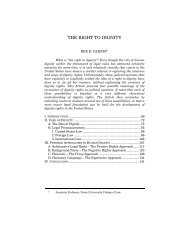A Right to Media? Lorie M. Graham - Columbia Law School
A Right to Media? Lorie M. Graham - Columbia Law School
A Right to Media? Lorie M. Graham - Columbia Law School
Create successful ePaper yourself
Turn your PDF publications into a flip-book with our unique Google optimized e-Paper software.
2010] A RIGHT TO MEDIA? 473<br />
culturally significant media focused on issues affecting indigenous<br />
communities.<br />
There are many examples of indigenous media throughout<br />
the world. Whether in the form of print, audio-visual, or digital,<br />
indigenous-run media is a growing industry. While it would not exist<br />
without the creativity, advocacy, and tenacity of indigenous<br />
communities, in some instances national governments and<br />
international agencies have partnered with indigenous peoples in<br />
order <strong>to</strong> facilitate and foster Indigenous media. This section will offer<br />
several examples of existing responses <strong>to</strong> the lack of indigenous<br />
voices in mainstream media, and will examine the challenges faced<br />
by indigenous peoples and states in the creation and maintenance of<br />
indigenous-run media. Additionally, this section will explore the<br />
connection between the goals of a right <strong>to</strong> media for indigenous<br />
peoples and the realities of what is being done at the domestic level.<br />
Unique his<strong>to</strong>ries and varying cultural norms make it difficult<br />
<strong>to</strong> speak of indigenous media as a monolithic industry. That being<br />
said, it is possible <strong>to</strong> identify from the following case studies common<br />
fac<strong>to</strong>rs that impact successful implementation of a right <strong>to</strong> media for<br />
indigenous peoples. These include the formal recognition of<br />
indigenous peoples’ self-determining rights <strong>to</strong> develop and access<br />
media; development of cultural and linguistic laws and initiatives <strong>to</strong><br />
support and strengthen media rights; development and improvement<br />
of telecommunication infrastructure <strong>to</strong> promote access and<br />
availability of media; development of public or state-run initiatives<br />
that promote indigenous programming and provide technical<br />
assistance and funding; and the existence of a dialogue on a code of<br />
ethics with respect <strong>to</strong> non-indigenous media coverage of indigenous<br />
communities. However, as the following examples also demonstrate,<br />
a host of larger societal, economic, and geographical challenges<br />
impact the development of indigenous media as well.<br />
The following case studies are country- or region-specific<br />
specific. Each begins with a description of domestic or regional<br />
action, followed by a detailed analysis of how those actions promote<br />
or undermine a right <strong>to</strong> media. Some of the case studies offer a more<br />
comprehensive approach <strong>to</strong> media rights, such as in Australia and<br />
New Zealand. Others are case specific, such as the efforts in Latin<br />
America and parts of Africa.















